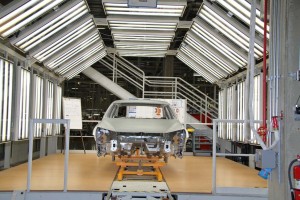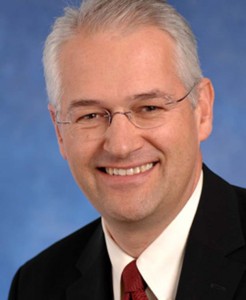
A VW Passat body under inspection at the maker's Chattanooga plant. Quality will be critical to meeting VW's ambitious growth target.
Half empty or half full? When it comes to Volkswagen, Jonathan Browning is looking at the glass from both angles.
By most measures, it’s been a particularly good week for the German maker. With sales for last month up 28.4%, VW is today reporting its best May since 1973. That news comes less than a day after the 100,000th new Passat rolled off the Volkswagen assembly plant in Chattanooga, Tennessee.
There are plenty of other reasons to be in a positive frame of mind, starting with the growing number of potential buyers who are now aware of products like the Passat, as well as the newly updated Beetle, the recently redesigned Jetta and the expanding line-up of Volkswagen diesels.
Nonetheless, the British-born Browning, CEO of the Volkswagen Group of America – which includes Audi and Bentley, as well as the VW brand – also sees quite a few reasons to worry whether the maker is operating “at a level that will support our growth.”
Perhaps the biggest challenge remains the issue of quality. Lags in the design and manufacturing processes nearly killed the maker’s U.S. operations, sales plunging to barely 12,000 a year in the early 1990s. Until recently, sales rode a particularly violent roller-coaster, the ups-and-downs often tracking the maker’s position in research conducted by the likes of J.D. Power and Associates and AutoPacific.
Over time, VW has had, “at best a mediocre performance” in the quality charts, Browning readily concedes.
VW continues to lag behind the industry average when it comes to off-the-line problems and longer-term reliability, cautions AutoPacific analystDavid Sullivan. “And it’s actually two issues that they face: not only the frequency of repairs but the high cost of repairs.”
Browning agrees those are serious issues, though he also contends the maker is addressing both. He forecasts a sharp rise in VW’s performance in the closely watched J.D. Power Initial Quality Survey when it is released later this month. That is echoed by industry analysts who note that anecdotal evidence suggests the new Passat has had relatively few launch snags despite being an all-new model built in an all-new plant using parts from new suppliers.
Getting third-party endorsements from Power, AutoPacific and the influential Consumer Reports magazine will clearly help should VW score as well as Browning anticipates. Even then, the executive frets offer what he terms a “disconnect” between perception and reality. U.S. buyers tend to have a very outdated image of the Volkswagen brand, one as likely as not to harken back to the era when the Beetle was its dominant product line.
As a result, VW scores extremely high on the charts in terms of brand awareness, notes Browning, “but when you get down to purchase intent we have a key disconnect.”
The challenge is to not only win over consumers skeptical about quality but also to make potential buyers aware of the much broader VW line-up of today. But, if anything, says analyst Sullivan, it needs to get even broader. “I think they know they can’t hit their target with the line-up they have today,” he says.
Browning appears to agree. As TheDetroitBureau.com reported earlier this week, the 52-year-old executive is pressing VW headquarters in Wolfsburg, Germany to approve plans for a midsize sport-utility/crossover vehicle that would slot neatly between the big Touareg and compact Tiguan models. Browning hints VW might also bring the subcompact Polo and new Up! microcar to the U.S.
(For more on VW’s future product plans, Click Here.)
While there are plenty of potential obstacles, Browning remains, on the whole, upbeat about the Volkswagen Group’s potential in the U.S. market, with the maker still on track to triple overall volumes to 800,000 by 2018 – the VW brand accounting for the vast majority of that, at a projected 600,000 sales a year.
To get there is likely to require a significant expansion of the maker’s North American production network – as the goal is to assemble at least 70% of the vehicles sold in the U.S. somewhere within the NAFTA region.
The maker has already committed to adding a third shift at the Chattanooga plant, which will add another 1,000 jobs and bump capacity to around 180,000 annually. By “breaking bottlenecks,” added Browning, the facility likely could reach 250,000. By then, it is possible Chattanooga will add a second model, though there are currently “no plans” specifically in the works.
The Tennessee plant – ironically built on an old U.S. Army Air Force munitions site used during World War II to support the German bombing campaign – has plenty of room to grow even further, Browning suggesting VW could “mirror” the existing assembly plant.
And then there’s its operations in Puebla, Mexico, with an annual capacity of 600,000 vehicles. Meanwhile, Audi is now planning to erect its own plant in Mexico.
All things told, Browning does come out the optimist, outlining the various steps VW plans to take to reach its admittedly ambitious goal. But he’s well aware that Volkswagen has had aggressive plans before that it failed to meet. It can’t afford to repeat past mistakes.


“Over time, VW has had, ‘at best a mediocre performance’ in the quality charts, Browning readily concedes.” A decided understatement. This continues to be the case. Excluding Porsche, a lack of reliability is endemic in all German brands, including BMW (speaking from recent personal experience on BMWs).
What’s equally problematic, as Browning noted, is the high cost of German vehicle repairs. A VERY close family member abandoned one of the high-end German brands, in large part, because of endemic service issues: ridiculous prices, questionable work and constant up-selling for unneeded work.
Paul A. Eisenstein
Publisher, TheDetroitBureau.com